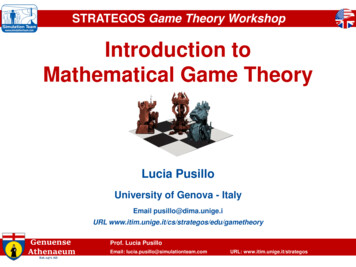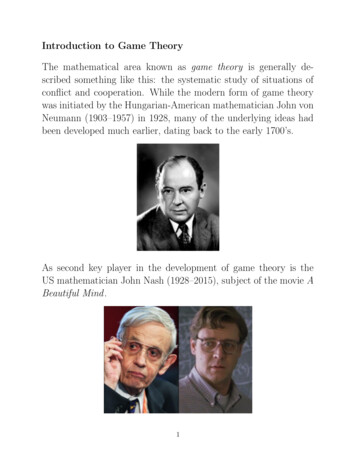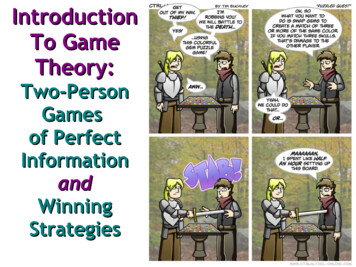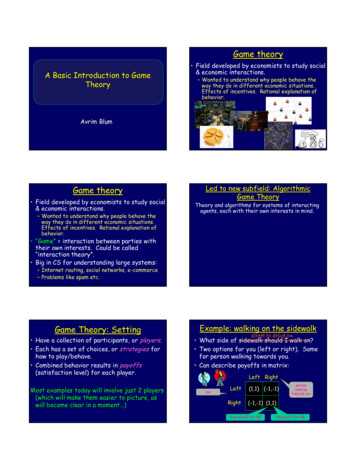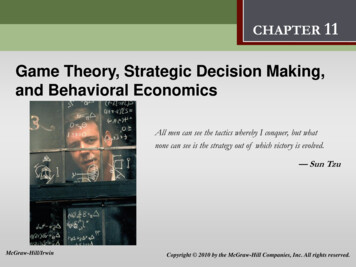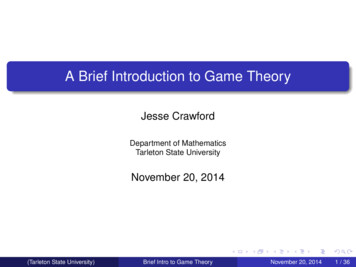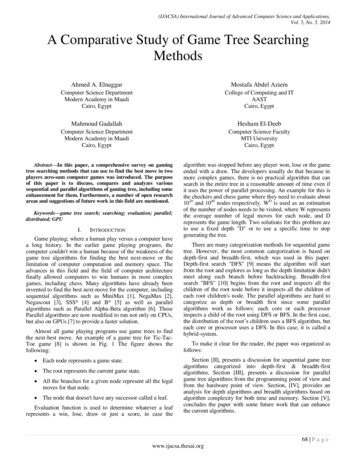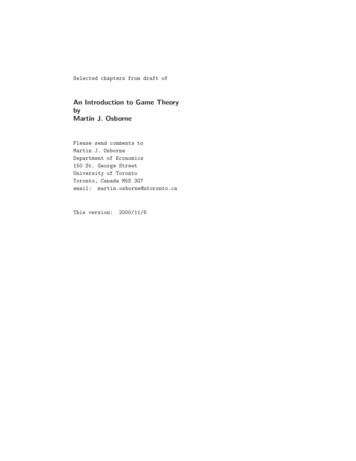
Transcription
Selected chapters from draft ofAn Introduction to Game TheorybyMartin J. OsbornePlease send comments toMartin J. OsborneDepartment of Economics150 St. George StreetUniversity of TorontoToronto, Canada M5S 3G7email: martin.osborne@utoronto.caThis version:2000/11/6
c 1995–2000 by Martin J. OsborneCopyright All rights reserved. No part of this book may be reproduced by any electronic or mechanical means(including photocopying, recording, or information storage and retrieval) without permission inwriting from Oxford University Press.
ContentsPreface1I2xiiiIntroduction 11.1 What is game theory? 1An outline of the history of game theoryJohn von Neumann 31.2 The theory of rational choice 41.3 Coming attractions 7Notes 8Games with Perfect Information39Nash Equilibrium: Theory 112.1 Strategic games 112.2 Example: the Prisoner’s Dilemma 122.3 Example: Bach or Stravinsky? 162.4 Example: Matching Pennies 172.5 Example: the Stag Hunt 182.6 Nash equilibrium 19John F. Nash, Jr. 20Studying Nash equilibrium experimentally 222.7 Examples of Nash equilibrium 24Experimental evidence on the Prisoner’s Dilemma 26Focal points 302.8 Best response functions 332.9 Dominated actions 432.10 Equilibrium in a single population: symmetric games and symmetricequilibria 49Notes 51v
vi3ContentsNash Equilibrium: Illustrations 533.1 Cournot’s model of oligopoly 533.2 Bertrand’s model of oligopoly 61Cournot, Bertrand, and Nash: some historical notes3.3 Electoral competition 683.4 The War of Attrition 753.5 Auctions 79Auctions from Babylonia to eBay 793.6 Accident law 89Notes 94674Mixed Strategy Equilibrium 974.1 Introduction 97Some evidence on expected payoff functions 1024.2 Strategic games in which players may randomize 1034.3 Mixed strategy Nash equilibrium 1054.4 Dominated actions 1174.5 Pure equilibria when randomization is allowed 1194.6 Illustration: expert diagnosis 1204.7 Equilibrium in a single population 1254.8 Illustration: reporting a crime 128Reporting a crime: social psychology and game theory 1304.9 The formation of players’ beliefs 1314.10 Extension: Finding all mixed strategy Nash equilibria 1354.11 Extension: Mixed strategy Nash equilibria of games in which each playerhas a continuum of actions 1394.12 Appendix: Representing preferences over lotteries by the expected value ofa payoff function 143Notes 1485Extensive Games with Perfect Information: Theory 1515.1 Introduction 1515.2 Extensive games with perfect information 1515.3 Strategies and outcomes 1575.4 Nash equilibrium 1595.5 Subgame perfect equilibrium 1625.6 Finding subgame perfect equilibria of finite horizon games: backwardinduction 167Ticktacktoe, chess, and related games 176Notes 177
Contentsvii6Extensive Games with Perfect Information: Illustrations6.1 Introduction 1796.2 The ultimatum game and the holdup game 179Experiments on the ultimatum game 1816.3 Stackelberg’s model of duopoly 1846.4 Buying votes 1896.5 A race 194Notes 2001797Extensive Games with Perfect Information: Extensions and Discussion 2017.1 Allowing for simultaneous moves 201More experimental evidence on subgame perfect equilibrium 2077.2 Illustration: entry into a monopolized industry 2097.3 Illustration: electoral competition with strategic voters 2117.4 Illustration: committee decision-making 2137.5 Illustration: exit from a declining industry 2177.6 Allowing for exogenous uncertainty 2227.7 Discussion: subgame perfect equilibrium and backward induction 226Experimental evidence on the centipede game 230Notes 2328Coalitional Games and the Core 2358.1 Coalitional games 2358.2 The core 2398.3 Illustration: ownership and the distribution of wealth 2438.4 Illustration: exchanging homogeneous horses 2478.5 Illustration: exchanging heterogeneous houses 2528.6 Illustration: voting 2568.7 Illustration: matching 259Matching doctors with hospitals 2648.8 Discussion: other solution concepts 265Notes 266
viiiContentsIIGames with Imperfect Information9Bayesian Games 2719.1 Introduction 2719.2 Motivational examples 2719.3 General definitions 2769.4 Two examples concerning information 2819.5 Illustration: Cournot’s duopoly game with imperfect information 2839.6 Illustration: providing a public good 2879.7 Illustration: auctions 290Auctions of the radio spectrum 2989.8 Illustration: juries 2999.9 Appendix: Analysis of auctions for an arbitrary distribution ofvaluations 306Notes 30910 Extensive games with imperfect information10.1 To be written 311Notes 312IIIVariants and Extensions26931133311 Strictly Competitive Games and Maxminimization 33511.1 Introduction 33511.2 Definitions and examples 33511.3 Strictly competitive games 338Maxminimization: some history 344Testing the theory of Nash equilibrium in strictly competitivegames 347Notes 34812 Rationalizability 34912.1 Introduction 34912.2 Iterated elimination of strictly dominated actions 35512.3 Iterated elimination of weakly dominated actions 359Notes 361
Contentsix13 Evolutionary Equilibrium 36313.1 Introduction 36313.2 Monomorphic pure strategy equilibrium 364Evolutionary game theory: some history 36913.3 Mixed strategies and polymorphic equilibrium 37013.4 Asymmetric equilibria 377Explaining the outcomes of contests in nature 37913.5 Variation on a theme: sibling behavior 38013.6 Variation on a theme: nesting behavior of wasps 386Notes 38814 Repeated games: The Prisoner’s Dilemma 38914.1 The main idea 38914.2 Preferences 39114.3 Infinitely repeated games 39314.4 Strategies 39414.5 Some Nash equilibria of the infinitely repeated Prisoner’s Dilemma 39614.6 Nash equilibrium payoffs of the infinitely repeated Prisoner’s Dilemma whenthe players are patient 39814.7 Subgame perfect equilibria and the one-deviation property 40214.8 Some subgame perfect equilibria of the infinitely repeated Prisoner’sDilemma 404Notes 40915 Repeated games: General Results 41115.1 Nash equilibria of general infinitely repeated games 41115.2 Subgame perfect equilibria of general infinitely repeated games 414Axelrod’s experiments 418Reciprocal altruism among sticklebacks 41915.3 Finitely repeated games 420Notes 42016 Bargaining 42116.1 To be written 42116.2 Repeated ultimatum game 42116.3 Holdup game 421
xContents17 Appendix: Mathematics17.1 Introduction 44317.2 Numbers 44317.3 Sets 44417.4 Functions 44517.5 Profiles 44817.6 Sequences 44917.7 Probability 44917.8 Proofs 454References457443
PrefaceGame theoretic reasoning pervades economic theory and is used widely in othersocial and behavioral sciences. This book presents the main ideas of game theoryand shows how they can be used to understand economic, social, political, and biological phenomena. It assumes no knowledge of economics, political science, orany other social or behavioral science. It emphasizes the ideas behind the theoryrather than their mathematical expression, and assumes no specific mathematicalknowledge beyond that typically taught in US and Canadian high schools. (Chapter 17 reviews the mathematical concepts used in the book.) In particular, calculusis not used, except in the appendix of Chapter 9 (Section 9.7). Nevertheless, allconcepts are defined precisely, and logical reasoning is used extensively. The morecomfortable you are with tight logical analysis, the easier you will find the arguments. In brief, my aim is to explain the main ideas of game theory as simply aspossible while maintaining complete precision.The only way to appreciate the theory is to see it in action, or better still to putit into action. So the book includes a wide variety of illustrations from the socialand behavioral sciences, and over 200 exercises.The structure of the book is illustrated in the figure on the next page. Thegray boxes indicate core chapters (the darker gray, the more important). An blackarrow from Chapter i to Chapter j means that Chapter j depends on Chapter i.The gray arrow from Chapter 4 to Chapter 9 means that the latter depends weaklyon the former; for all but Section 9.8 only an understanding of expected payoffs(Section 4.1.3) is required, not a knowledge of mixed strategy Nash equilibrium.(Two chapters are not included in this figure: Chapter 1 reviews the theory of asingle rational decision-maker, and Chapter 17 reviews the mathematical conceptsused in the book.)Each topic is presented with the aid of “Examples”, which highlight theoretical points, and “Illustrations”, which demonstrate how the theory may be used tounderstand social, economic, political, and biological phenomena. The “Illustrations” for the key models of strategic and extensive games are grouped in separatechapters (3 and 6), whereas those for the other models occupy the same chaptersas the theory. The “Illustrations” introduce no new theoretical points, and any orall of them may be skipped without loss of continuity.The limited dependencies between chapters mean that several routes may betaken through the book. At a minimum, you should study Chapters 2 (Nash Equilibrium: Theory)and 5 (Extensive Games with Perfect Information: Theory). Optionally you may sample some sections of Chapters 3 (Nash Equilibrium:
14PrefaceStrategic games3: Illustrations4: Mixed strategiesImperfect information2: Theory9: Bayesian gamesTopics11: Maxminimization12: Rationalizability13: Evolutionary equilibriumExtensive games6: Illustrations7: ExtensionsImperfect information5: Theory10: Signaling gamesTopics14, 15: Repeated games (I, II)Coalitional games16: Bargaining8: CorexivFigure 0.1 The structure of the book. The area of each box is proportional to the length of the chapterthe box represents. The boxes corresponding to the core chapters are shaded gray; the ones shaded darkgray are more central that the ones shaded light gray. An arrow from Chapter i to Chapter j means thatChapter i is a prerequisite for Chapter j. The gray arrow from Chapter 4 to Chapter 9 means that thelatter depends only weakly on the former.
Preface15Illustrations) and 6 (Extensive Games with Perfect Information: Illustrations). You may add to this plan any combination of Chapters 4 (Mixed StrategyEquilibrium), 9 (Bayesian Games, except Section 9.8), 7 (Extensive Gameswith Perfect Information: Extensions and Discussion), 8 (Coalitional Gamesand the Core), and 16 (Bargaining). If you read Chapter 4 (Mixed Strategy Equilibrium) then you may in additionstudy any combination of the remaining chapters covering strategic games,and if you study Chapter 7 (Extensive Games with Perfect Information: Extensions and Discussion) then you are ready to tackle Chapters 14 and 15(Repeated Games).All the material should be accessible to undergraduate students. A one-semestercourse for third or fourth year North American economics majors (who have beenexposed to a few of the main ideas in first and second year courses) could coverup to about half the material in the book in moderate detail.Personal pronounsThe lack of a sex-neutral third person singular pronoun in English has led manywriters of formal English to use “he” for this purpose. Such usage conflicts withthat of everyday speech. People may say “when an airplane pilot is working, heneeds to concentrate”, but they do not usually say “when a flight attendant isworking, he needs to concentrate” or “when a secretary is working, he needs toconcetrate”. The use of “he” only for roles in which men traditionally predominate in Western societies suggests that women may not play such roles; I find thisinsinuation unacceptable.To quote the New Oxford Dictionary of English, “[the use of he to refer to refer toa person of unspecified sex] has become . . . a hallmark of old-fashioned languageor sexism in language.” Writers have become sensitive to this issue in the last halfcentury, but the lack of a sex-neutral pronoun “has been felt since at least as farback as Middle English” (Webster’s Dictionary of English Usage, Merriam-WebsterInc., 1989, p. 499). A common solution has been to use “they”, a usage that theNew Oxford Dictionary of English endorses (and employs). This solution can createambiguity when the pronoun follows references to more than one person; it alsodoes not always sound natural. I choose a different solution: I use “she” exclusively. Obviously this usage, like that of “he”, is not sex-neutral; but its use maydo something to counterbalance the widespread use of “he”, and does not seemlikely to do any harm.AcknowledgementsI owe a huge debt to Ariel Rubinstein. I have learned, and continue to learn, vastlyfrom him about game theory. His influence on this book will be clear to anyone
16Prefacefamiliar with our jointly-authored book A course in game theory. Had we not writtenthat book and our previous book Bargaining and markets, I doubt that I would haveembarked on this project.Discussions over the years with Jean-Pierre Benoı̂t, Vijay Krishna, Michael Peters, and Carolyn Pitchik have improved my understanding of many game theoretic topics.Many people have generously commented on all or parts of drafts of the book.I am particularly grateful to Jeffrey Banks, Nikolaos Benos, Ted Bergstrom, TilmanBörgers, Randy Calvert, Vu Cao, Rachel Croson, Eddie Dekel, Marina De Vos, Laurie Duke, Patrick Elias, Mukesh Eswaran, Xinhua Gu, Costas Halatsis, Joe Harrington, Hiroyuki Kawakatsu, Lewis Kornhauser, Jack Leach, Simon Link, BartLipman, Kin Chung Lo, Massimo Marinacci, Peter McCabe, Barry O’Neill, RobinG. Osborne, Marco Ottaviani, Marie Rekkas, Bob Rosenthal, Al Roth, MatthewShum, Giora Slutzki, Michael Smart, Nick Vriend, and Chuck Wilson.I thank also the anonymous reviewers consulted by Oxford University Pressand several other presses; the suggestions in their reviews greatly improved thebook.The book has its origins in a course I taught at Columbia University in the early1980s. My experience in that course, and in courses at McMaster University, whereI taught from early drafts, and at the University of Toronto, brought the book toits current form. The Kyoto Institute of Economic Research at Kyoto Universityprovided me with a splendid environment in which to work on the book duringtwo months in 1999.ReferencesThe “Notes” section at the end of each chapter attempts to assign credit for theideas in the chapter. Several cases present difficulties. In some cases, ideas evolvedover a long period of time, with contributions by many people, making their origins hard to summarize in a sentence or two. In a few cases, my research has ledto a conclusion about the origins of an idea different from the standard one. In allcases, I cite the relevant papers without regard to their difficulty.Over the years, I have taken exercises from many sources. I have attemptedto remember where I got them from, and have given credit, but I have probablymissed some.Examples addressing economic, political, and biological issuesThe following tables list examples that address economic, political, and biologicalissues. [SO FAR CHECKED ONLY THROUGH CHAPTER 7.]Games related to economic issues (THROUGH CHAPTER 7)
Preface17Exercise 31.1,Section 2.8.4,Exercise 42.1Provision of a public goodSection 2.9.4Collective decision-makingSection 3.1,Exercise 133.1Cournot’s model of oligopolySection 3.1.5Common propertySection 3.2,Exercise 133.2,Exercise 143.2,Exercise 189.1,Exercise 210.1Bertrand’s model of oligopolyExercise 75.1Competition in product characteristicsSection 3.5Auctions with perfect informationSection 3.6Accident lawSection 4.6Expert diagnosisExercise 125.2,Exercise 208.1Price competition between sellersSection 4.8Reporting a crime (private provision of a public good)Example 141.1All-pay auction with perfect informationExercise 172.2Entry into an industry by a financially-constrained challengerExercise 175.1The “rotten kid theorem”Section 6.2.2The holdup gameSection 6.3Stackelberg’s model of duopolyExercise 207.2A market gameSection 7.2Entry into a monopolized industrySection 7.5Exit from a declining industryExample 227.1Chain-store gameGames related to political issues (THROUGH CHAPTER 7)Exercise 32.2Voter participationSection 2.9.3VotingExercise 47.3Approval votingSection 2.9.4Collective decision-makingSection 3.3,Exercise 193.3,Exercise 193.4,Section 7.3Hotelling’s model of electoral competition
18PrefaceExercise 73.1Electoral competition between policy-motivated candidatesExercise 73.2Electoral competition between citizen-candidatesExercise 88.3Lobbying as an auctionExercise 115.3Voter participationExercise 139.1Allocating resources in election campaignsSection 6.4Buying votes in a legislatureSection 7.4Committee decision-makingExercise 224.1Cohesion of governing coalitionsGames related to biological issues (THROUGH CHAPTER 7)Exercise 16.1Hermaphroditic fishSection 3.4War of attritionTypographic conventions, numbering, and nomenclatureIn formal definitions, the terms being defined are set in boldface. Terms are set initalics when they are defined informally.Definitions, propositions, examples, and exercises are numbered according tothe page on which they appear. If the first such object on page z is an exercise, forexample, it is called Exercise z.1; if the next object on that page is a definition, it iscalled Definition z.2. For example, the definition of a strategic game with ordinalpreferences on page 11 is Definition 11.1. This scheme allows numbered items tofound rapidly, and also facilitates precise index entries.Symbol/termMeaning?Exercise?Hard exercise DefinitionPropositionExample: a game that illustrates a game-theoretic pointIllustrationA game, or family of games, that shows how the theory can illuminate observed phenomenaI maintain a website for the book. The current URL ishttp://www.economics.utoronto.ca/osborne/igt/.
Draft chapter from An introduction to game theory by Martin J. OsborneOsborne@chass.utoronto.ca; www.economics.utoronto.ca/osborneVersion: 00/11/6.c 1995–2000 by Martin J. Osborne. All rights reserved. No part of this book may be reCopyright produced by any electronic or mechanical means (including photocopying, recording, or informationstorage and retrieval) without permission in writing from Oxford University Press, except that onecopy of up to six chapters may be made by any individual for private study.1IntroductionWhat is game theory? 1The theory of rational choice1.1G4What is game theory?AME THEORY aims to help us understand situations in which decision-makersinteract. A game in the everyday sense—“a competitive activity . . . in whichplayers contend with each other according to a set of rules”, in the words of mydictionary—is an example of such a situation, but the scope of game theory isvastly larger. Indeed, I devote very little space to games in the everyday sense;my main focus is the use of game theory to illuminate economic, political, andbiological phenomena.A list of some of the applications I discuss will give you an idea of the rangeof situations to which game theory can be applied: firms competing for business,political candidates competing for votes, jury members deciding on a verdict, animals fighting over prey, bidders competing in an auction, the evolution of siblings’behavior towards each other, competing experts’ incentives to provide correct diagnoses, legislators’ voting behavior under pressure from interest groups, and therole of threats and punishment in long-term relationships.Like other sciences, game theory consists of a collection of models. A modelis an abstraction we use to understand our observations and experiences. What“understanding” entails is not clear-cut. Partly, at least, it entails our perceivingrelationships between situations, isolating principles that apply to a range of problems, so that we can fit into our thinking new situations that we encounter. Forexample, we may fit our observation of the path taken by a lobbed tennis ball intoa model that assumes the ball moves forward at a constant velocity and is pulledtowards the ground by the constant force of “gravity”. This model enhances ourunderstanding because it fits well no matter how hard or in which direction theball is hit, and applies also to the paths taken by baseballs, cricket balls, and awide variety of other missiles, launched in any direction.A model is unlikely to help us understand a phenomenon if its assumptions arewildly at odds with our observations. At the same time, a model derives powerfrom its simplicity; the assumptions upon which it rests should capture the essence1
2Chapter 1. Introductionof the situation, not irrelevant details. For example, when considering the pathtaken by a lobbed tennis ball we should ignore the dependence of the force ofgravity on the distance of the ball from the surface of the earth.Models cannot be judged by an absolute criterion: they are neither “right” nor“wrong”. Whether a model is useful or not depends, in part, on the purpose forwhich we use it. For example, when I determine the shortest route from Florenceto Venice, I do not worry about the projection of the map I am using; I work underthe assumption that the earth is flat. When I determine the shortest route fromBeijing to Havana, however, I pay close attention to the projection—I assume thatthe earth is spherical. And were I to climb the Matterhorn I would assume that theearth is neither flat nor spherical!One reason for improving our understanding of the world is to enhance ourability to mold it to our desires. The understanding that game theoretic modelsgive is particularly relevant in the social, political, and economic arenas. Studyinggame theoretic models (or other models that apply to human interaction) may alsosuggest ways in which our behavior may be modified to improve our own welfare.By analyzing the incentives faced by negotiators locked in battle, for example, wemay see the advantages and disadvantages of various strategies.The models of game theory are precise expressions of ideas that can be presented verbally. However, verbal descriptions tend to be long and imprecise; inthe interest of conciseness and precision, I frequently use mathematical symbolswhen describing models. Although I use the language of mathematics, I use fewof its concepts; the ones I use are described in Chapter 17. My aim is to take advantage of the precision and conciseness of a mathematical formulation withoutlosing sight of the underlying ideas.Game-theoretic modeling starts with an idea related to some aspect of the interaction of decision-makers. We express this idea precisely in a model, incorporatingfeatures of the situation that appear to be relevant. This step is an art. We wish toput enough ingredients into the model to obtain nontrivial insights, but not somany that we are lead into irrelevant complications; we wish to lay bare the underlying structure of the situation as opposed to describe its every detail. The nextstep is to analyze the model—to discover its implications. At this stage we need toadhere to the rigors of logic; we must not introduce extraneous considerations absent from the model. Our analysis may yield results that confirm our idea, or thatsuggest it is wrong. If it is wrong, the analysis should help us to understand whyit is wrong. We may see that an assumption is inappropriate, or that an importantelement is missing from the model; we may conclude that our idea is invalid, orthat we need to investigate it further by studying a different model. Thus, the interaction between our ideas and models designed to shed light on them runs intwo directions: the implications of models help us determine whether our ideasmake sense, and these ideas, in the light of the implications of the models, mayshow us how the assumptions of our models are inappropriate. In either case, theprocess of formulating and analyzing a model should improve our understandingof the situation we are considering.
1.1 What is game theory?3A N OUTLINE OF THE HISTORY OF GAME THEORYSome game-theoretic ideas can be traced to the 18th century, but the major development of the theory began in the 1920s with the work of the mathematicianEmile Borel (1871–1956) and the polymath John von Neumann (1903–57). A decisive event in the development of the theory was the publication in 1944 of thebook Theory of games and economic behavior by von Neumann and Oskar Morgenstern. In the 1950s game-theoretic models began to be used in economic theoryand political science, and psychologists began studying how human subjects behave in experimental games. In the 1970s game theory was first used as a tool inevolutionary biology. Subsequently, game theoretic methods have come to dominate microeconomic theory and are used also in many other fields of economicsand a wide range of other social and behavioral sciences. The 1994 Nobel prize ineconomics was awarded to the game theorists John C. Harsanyi (1920–2000), JohnF. Nash (1928–), and Reinhard Selten (1930–).J OHN VON N EUMANNJohn von Neumann, the most important figure in the early development of gametheory, was born in Budapest, Hungary, in 1903. He displayed exceptional mathematical ability as a child (he had mastered calculus by the age of 8), but his father, concerned about his son’s financial prospects, did not want him to become amathematician. As a compromise he enrolled in mathematics at the University ofBudapest in 1921, but immediately left to study chemistry, first at the Universityof Berlin and subsequently at the Swiss Federal Institute of Technology in Zurich,from which he earned a degree in chemical engineering in 1925. During his time inGermany and Switzerland he returned to Budapest to write examinations, and in1926 obtained a PhD in mathematics from the University of Budapest. He taughtin Berlin and Hamburg, and, from 1930 to 1933, at Princeton University. In 1933 hebecame the youngest of the first six professors of the School of Mathematics at theInstitute for Advanced Study in Princeton (Einstein was another).Von Neumann’s first published scientific paper appeared in 1922, when he was19 years old. In 1928 he published a paper that establishes a key result on strictlycompetitive games (a result that had eluded Borel). He made many major contributions in pure and applied mathematics and in physics—enough, according to Halmos (1973), “for about three ordinary careers, in pure mathematics alone”. Whileat the Institute for Advanced Study he collaborated with the Princeton economistOskar Morgenstern in writing Theory of games and economic behavior, the book thatestablished game theory as a field. In the 1940s he became increasingly involvedin applied work. In 1943 he became a consultant to the Manhattan project, whichwas developing an atomic bomb. In 1944 he became involved with the development of the first electronic computer, to which he made major contributions. He
4Chapter 1. Introductionstayed at Princeton until 1954, when he became a member of the US Atomic EnergyCommission. He died in 1957.1.2The theory of rational choiceThe theory of rational choice is a component of many models in game theory.Briefly, this theory is that a decision-maker chooses the best action according toher preferences, among all the actions available to her. No qualitative restrictionis placed on the decision-maker’s preferences; her “rationality” lies in the consistency of her decisions when faced with different sets of available actions, not in thenature of her likes and dislikes.1.2.1 ActionsThe theory is based on a model with two components: a set A consisting of allthe actions that, under some circumstances, are available to the decision-maker,and a specification of the decision-maker’s preferences. In any given situationthe decision-maker is faced with a subset1 of A, from which she must choose asingle element. The decision-maker knows this subset of available choices, andtakes it as given; in particular, the subset is not influenced by the decision-maker’spreferences. The set A could, for example, be the set of bundles of goods thatthe decision-maker can possibly consume; given her income at any time, she isrestricted to choose from the subset of A containing the bundles she can afford.1.2.2 Preferences and payoff functionsAs to preferences, we assume that the decision-maker, when presented with anypair of actions, knows which of the pair she prefers, or knows that she regardsboth actions as equally desirable (is “indifferent between the actions”). We assumefurther that these preferences are consistent in the sense that if the decision-makerprefers the action a to the action b, and the action b to the action c, then she prefersthe action a to the action c. No other restriction is imposed on preferences. In particular, we do not rule out the possibility that a person’s preferences are altruisticin the sense that how much she likes an outcome depends on some other person’swelfare. Theories that use the model of rational choice aim to derive implicationsthat do not depend on any qualitative characteristic of preferences.How can we describe a decision-maker’s preferences? One way is to specify,for each possible pair of actions, the action the decision-maker prefers, or to notethat the decision-maker is indifferent between the actions. Alternatively we can“represent” the preferences by a payoff function, which associates a number witheach action in such a way that actions with higher numbers are preferred. More1 SeeChapter 17 for a description of mathematical terminology.
1.2 The theory of rational choice5precisely, the payoff function u represents a decision-maker’s preferences if, forany actions a in A and b in A,u(a) u(b) if and only if the decision-maker prefers a to b.(5.1)(A better name than payoff function might be “preference indicator function”;in economic theory a payoff function that represents a consumer’s preferences isoften referred to as a “utility function”.)E XAMPLE 5.2 (Payoff function representing preferences) A person is faced withthe choice of three vacation packages, to Havana, Paris, and Venice. She prefersthe package to Havana to the other two, which she regards as equiva
Nov 06, 2000 · Game theoretic reasoning pervades economic theory and is used widely in other social and behavioral sciences. This book presents the main ideas of game theory and shows how they can be used to understand economic, social, political, and bi-ological phenomena. It
